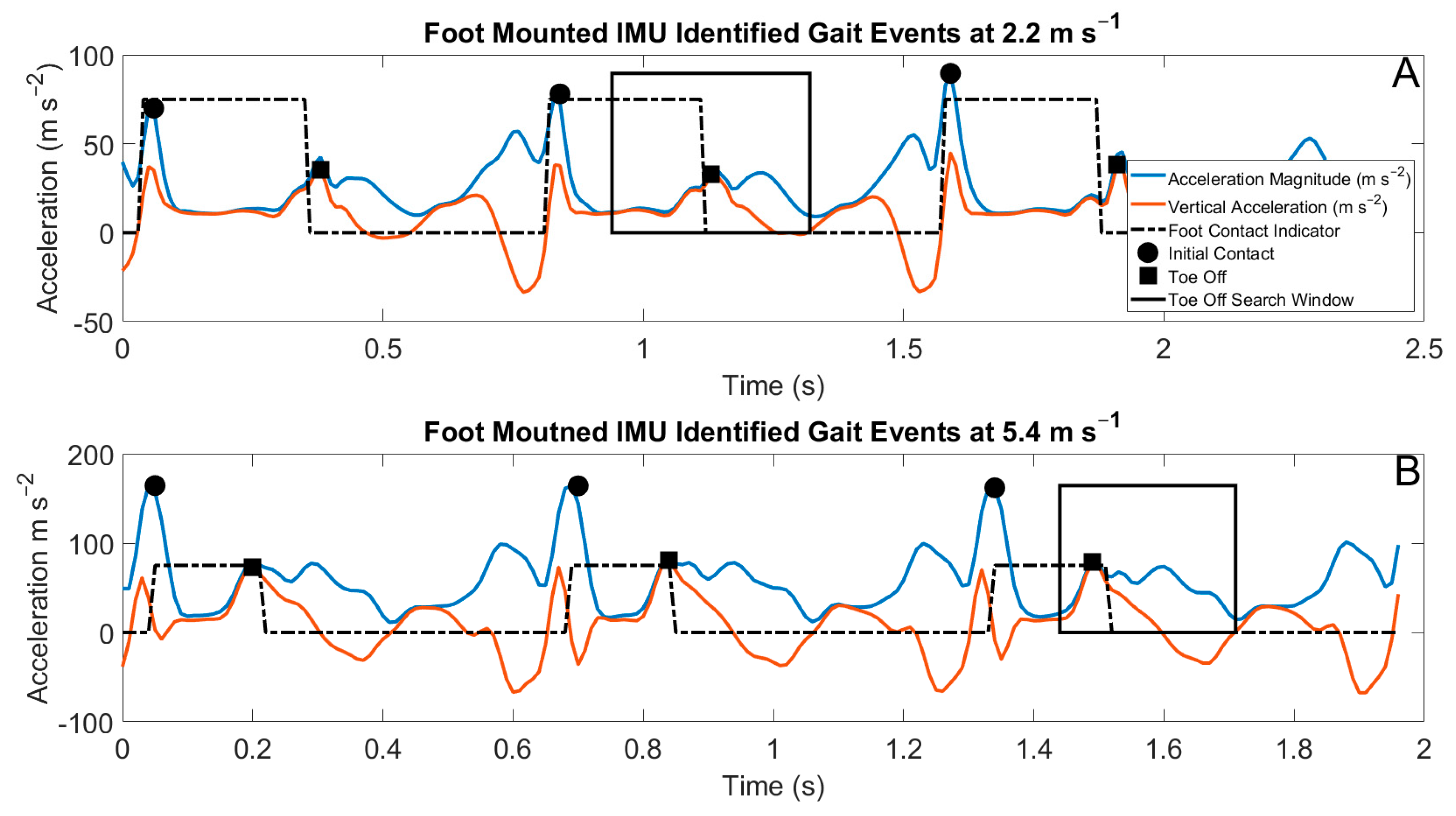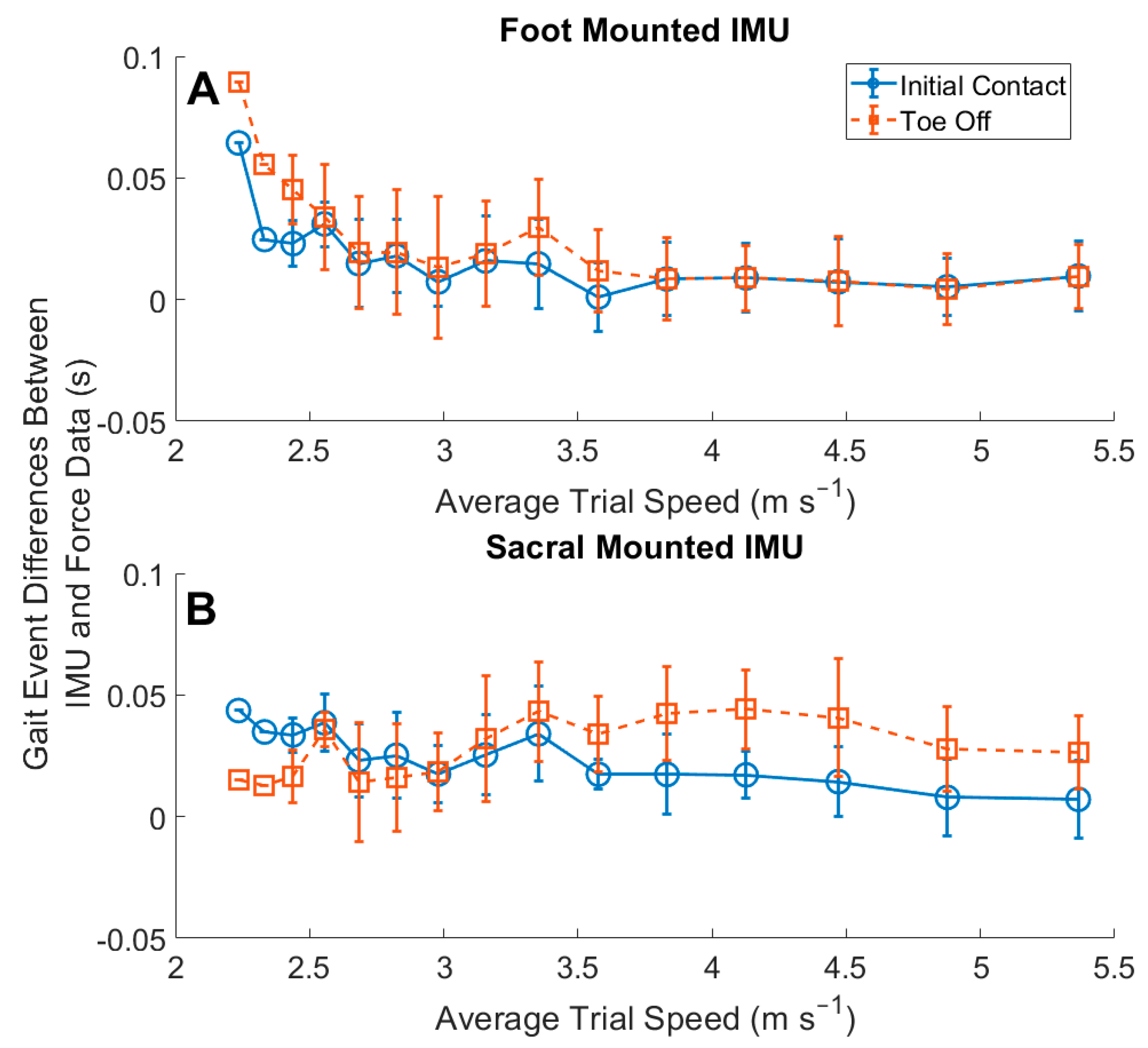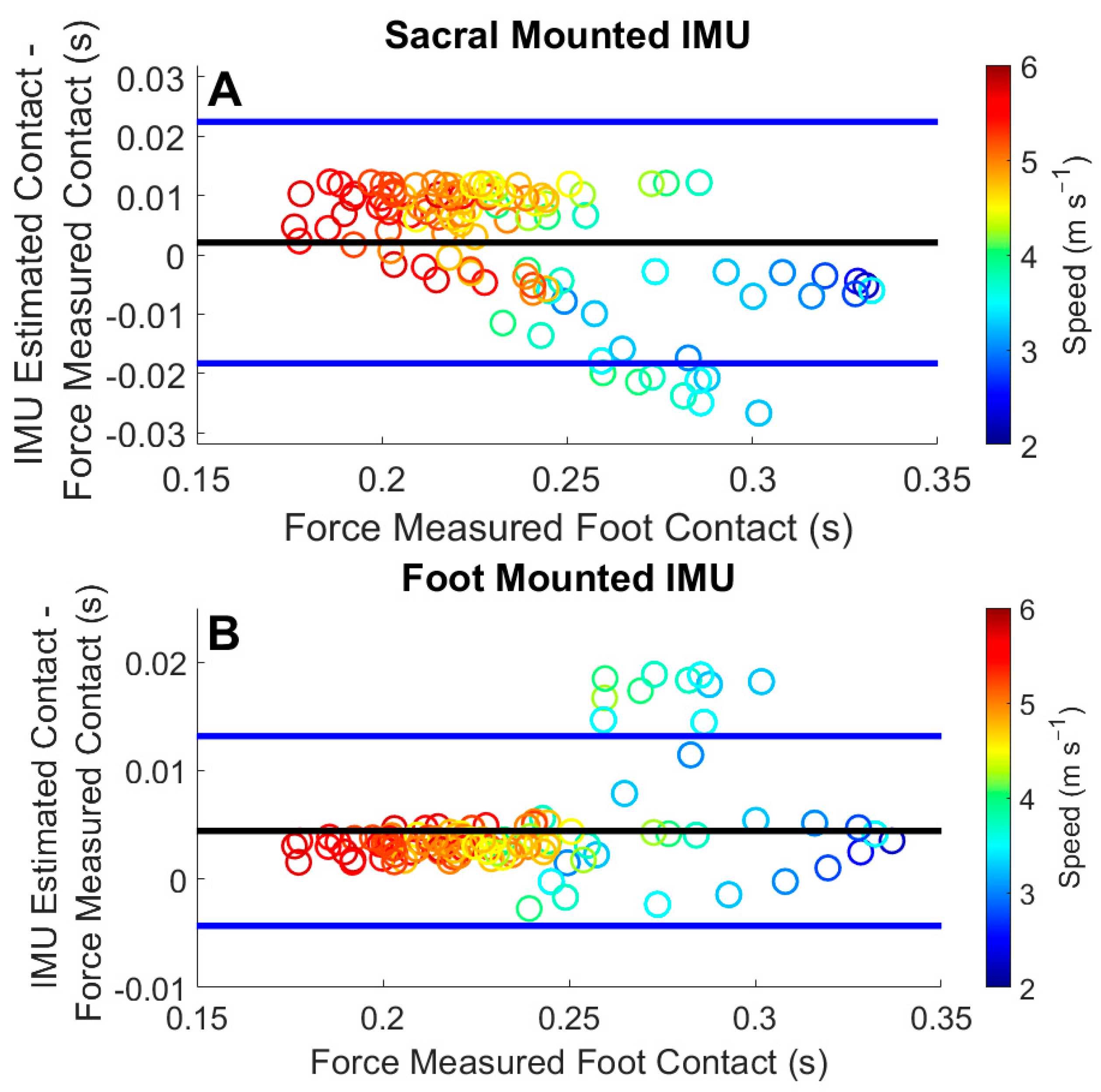Validation of Running Gait Event Detection Algorithms in a Semi-Uncontrolled Environment
Abstract
:1. Introduction
2. Materials and Methods
3. Results
4. Discussion
5. Conclusions
Author Contributions
Funding
Institutional Review Board Statement
Informed Consent Statement
Data Availability Statement
Acknowledgments
Conflicts of Interest
References
- Norris, M.; Anderson, R.; Kenny, I.C. Method analysis of accelerometers and gyroscopes in running gait: A systematic review. Proc. Inst. Mech. Eng. Part P J. Sports Eng. Technol. 2014, 228, 3–15. [Google Scholar] [CrossRef] [Green Version]
- Paquette, M.R.; Napier, C.; Willy, R.W.; Stellingwerff, T. Moving Beyond Weekly ‘Distance’: Optimizing Quantification of Training Load in Runners. J. Orthop. Sports Phys. Ther. 2020, 50, 564–569. [Google Scholar] [CrossRef] [PubMed]
- Milner, C.E.; Paquette, M.R. A kinematic method to detect foot contact during running for all foot strike patterns. J. Biomech. 2015, 48, 3502–3505. [Google Scholar] [CrossRef] [PubMed]
- Winter, D.A. Kinematic and kinetic patterns in human gait: Variability and compensating effects. Hum. Mov. Sci. 1984, 3, 51–76. [Google Scholar] [CrossRef]
- Agostini, V.; Balestra, G.; Knaflitz, M. Segmentation and classification of gait cycles. IEEE Trans. Neural Syst. Rehabil. Eng. 2014, 22, 946–952. [Google Scholar] [CrossRef] [Green Version]
- Prasanth, H.; Caban, M.; Keller, U.; Courtine, G.; Ijspeert, A.; Vallery, H.; von Zitzewitz, J. Wearable sensor-based real-time gait detection: A systematic review. Sensors 2021, 21, 2727. [Google Scholar] [CrossRef]
- Taborri, J.; Palermo, E.; Rossi, S.; Cappa, P. Gait partitioning methods: A systematic review. Sensors 2016, 16, 66. [Google Scholar] [CrossRef] [Green Version]
- Day, E.M.; Alcantara, R.S.; McGeehan, M.A.; Grabowski, A.M.; Hahn, M.E. Low-pass filter cutoff frequency affects sacral-mounted inertial measurement unit estimations of peak vertical ground reaction force and contact time during treadmill running. J. Biomech. 2021, 119, 110323. [Google Scholar] [CrossRef]
- Mo, S.; Chow, D.H.K. Accuracy of three methods in gait event detection during overground running. Gait Posture 2018, 59, 93–98. [Google Scholar] [CrossRef]
- Sinclair, J.; Hobbs, S.J.; Protheroe, L.; Edmundson, C.J.; Greenhalgh, A. Determination of gait events using an externally mounted shank accelerometer. J. Appl. Biomech. 2013, 29, 118–122. [Google Scholar] [CrossRef] [Green Version]
- Aubol, K.G.; Milner, C.E. Foot contact identification using a single triaxial accelerometer during running. J. Biomech. 2020, 105, 109768. [Google Scholar] [CrossRef] [PubMed]
- Zrenner, M.; Küderle, A.; Roth, N.; Jensen, U.; Dümler, B.; Eskofier, B.M. Does the position of foot-mounted imu sensors influence the accuracy of spatio-temporal parameters in endurance running? Sensors 2020, 20, 5705. [Google Scholar] [CrossRef] [PubMed]
- Strohrmann, C.; Harms, H.; Kappeler-Setz, C.; Troster, G. Monitoring Kinematic Changes with Fatigue in Running Using Body-Worn Sensors. IEEE Trans. Inf. Technol. Biomed. 2012, 16, 983–990. [Google Scholar] [CrossRef] [PubMed]
- Rebula, J.R.; Ojeda, L.V.; Adamczyk, P.G.; Kuo, A.D. Measurement of foot placement and its variability with inertial sensors. Gait Posture 2013, 38, 974–980. [Google Scholar] [CrossRef] [PubMed] [Green Version]
- Zaferiou, A.M.; Ojeda, L.V.; Cain, S.M.; Vitali, R.V.; Davidson, S.P.; Stirling, L.; Perkins, N.C. Quantifying performance on an outdoor agility drill using foot-mounted inertial measurement units. PLoS ONE 2017, 12, e0188184. [Google Scholar] [CrossRef] [Green Version]
- Clermont, C.A.; Benson, L.C.; Edwards, W.B.; Hettinga, B.A.; Ferber, R. New Considerations for Wearable Technology Data: Changes in Running Biomechanics During a Marathon. J. Appl. Biomech. 2019, 35, 401–409. [Google Scholar] [CrossRef]
- Benson, L.C.; Clermont, C.A.; Ferber, R. New Considerations for Collecting Biomechanical Data Using Wearable Sensors: The Effect of Different Running Environments. Front. Bioeng. Biotechnol. 2020, 8, 86. [Google Scholar] [CrossRef] [Green Version]
- Benson, L.C.; Clermont, C.A.; Bošnjak, E.; Ferber, R. The use of wearable devices for walking and running gait analysis outside of the lab: A systematic review. Gait Posture 2018, 63, 124–138. [Google Scholar] [CrossRef]
- Lee, H. Task-dependent modulation of multi-dimensional human ankle stiffness. In Powered Prostheses; Elsevier: Amsterdam, The Netherlands, 2020; pp. 41–56. ISBN 9780128174500. [Google Scholar]
- Lee, J.B.; Mellifont, R.B.; Burkett, B.J. The use of a single inertial sensor to identify stride, step, and stance durations of running gait. J. Sci. Med. Sport 2010, 13, 270–273. [Google Scholar] [CrossRef]
- Giandolini, M.; Horvais, N.; Rossi, J.; Millet, G.Y.; Samozino, P.; Morin, J.B. Foot strike pattern differently affects the axial and transverse components of shock acceleration and attenuation in downhill trail running. J. Biomech. 2016, 49, 1765–1771. [Google Scholar] [CrossRef]
- Reenalda, J.; Maartens, E.; Homan, L.; Buurke, J.H. Continuous three dimensional analysis of running mechanics during a marathon by means of inertial magnetic measurement units to objectify changes in running mechanics. J. Biomech. 2016, 49, 3362–3367. [Google Scholar] [CrossRef] [PubMed]
- Auvinet, B.; Gloria, E.; Renault, G.; Barrey, E. Runner’s stride analysis: Comparison of kinematic and kinetic analyses under field conditions. Sci. Sports 2002, 17, 92–94. [Google Scholar] [CrossRef]
- Wixted, A.J.; Billing, D.C.; James, D.A. Validation of trunk mounted inertial sensors for analysing running biomechanics under field conditions, using synchronously collected foot contact data. Sports Eng. 2010, 12, 207–212. [Google Scholar] [CrossRef] [Green Version]
- Chew, D.K.; Ngoh, K.J.H.; Gouwanda, D.; Gopalai, A.A. Estimating running spatial and temporal parameters using an inertial sensor. Sports Eng. 2018, 21, 115–122. [Google Scholar] [CrossRef]
- Watari, R.; Hettinga, B.; Osis, S.; Ferber, R. Validation of a torso-mounted accelerometer for measures of vertical oscillation and ground contact time during treadmill running. J. Appl. Biomech. 2016, 32, 306–310. [Google Scholar] [CrossRef]
- Renner, K.E.; Blaise Williams, D.S.; Queen, R.M. The reliability and validity of the Loadsol® under various walking and running conditions. Sensors 2019, 19, 265. [Google Scholar] [CrossRef] [Green Version]
- Weyand, P.G.; Sandell, R.F.; Prime, D.N.L.; Bundle, M.W. The biological limits to running speed are imposed from the ground up. J. Appl. Physiol. 2010, 108, 950–961. [Google Scholar] [CrossRef] [Green Version]
- Benson, L.C.; Clermont, C.A.; Watari, R.; Exley, T.; Ferber, R. Automated accelerometer-based gait event detection during multiple running conditions. Sensors 2019, 19, 1483. [Google Scholar] [CrossRef] [Green Version]
- Fukuchi, R.K.; Fukuchi, C.A.; Duarte, M. A public dataset of running biomechanics and the effects of running speed on lower extremity kinematics and kinetics. PeerJ 2017, 2017, 3298. [Google Scholar] [CrossRef] [Green Version]
- Clermont, C.A.; Benson, L.C.; Osis, S.T.; Kobsar, D.; Ferber, R. Running patterns for male and female competitive and recreational runners based on accelerometer data. J. Sports Sci. 2019, 37, 204–211. [Google Scholar] [CrossRef]







| Average Running Velocity (m s−1) | Number of Participants |
|---|---|
| 2.23 | 1 |
| 2.33 | 1 |
| 2.43 | 1 |
| 2.55 | 4 |
| 2.68 | 6 |
| 2.82 | 6 |
| 2.98 | 6 |
| 3.15 | 7 |
| 3.35 | 9 |
| 3.57 | 9 |
| 3.83 | 9 |
| 4.12 | 8 |
| 4.47 | 8 |
| 4.87 | 7 |
| 5.36 | 7 |
| Example Paces | Average Velocity (m s−1) | Minutes per Mile |
|---|---|---|
| Pace 1 | 3.15 | 8:30 |
| Pace 2 | 3.35 | 8:00 |
| Pace 3 | 3.57 | 7:30 |
| Pace 4 | 3.83 | 7:00 |
| Pace 5 (optional) | 4.12 | 6:30 |
| Foot-Mounted | Sacral-Mounted | |||||
|---|---|---|---|---|---|---|
| Velocity (m s−1) | Initial Contact (s) | Toe Off (s) | Contact Time (s) | Initial Contact (s) | Toe Off (s) | Contact Time (s) |
| 2.24 | 0.074 | 0.092 | 0.025 | 0.045 | 0.059 | 0.043 |
| 2.33 | 0.026 | 0.060 | 0.045 | 0.038 | 0.021 | 0.030 |
| 2.44 | 0.024 | 0.044 | 0.026 | 0.035 | 0.027 | 0.026 |
| 2.55 | 0.033 | 0.064 | 0.054 | 0.039 | 0.036 | 0.024 |
| 2.68 | 0.024 | 0.040 | 0.038 | 0.028 | 0.028 | 0.490 |
| 2.82 | 0.024 | 0.034 | 0.029 | 0.030 | 0.032 | 0.030 |
| 2.98 | 0.018 | 0.039 | 0.035 | 0.024 | 0.032 | 0.027 |
| 3.16 | 0.024 | 0.036 | 0.032 | 0.029 | 0.042 | 0.029 |
| 3.35 | 0.024 | 0.035 | 0.025 | 0.039 | 0.051 | 0.036 |
| 3.58 | 0.018 | 0.023 | 0.022 | 0.019 | 0.042 | 0.037 |
| 3.83 | 0.020 | 0.031 | 0.028 | 0.024 | 0.045 | 0.036 |
| 4.13 | 0.019 | 0.024 | 0.023 | 0.020 | 0.047 | 0.039 |
| 4.47 | 0.021 | 0.026 | 0.021 | 0.020 | 0.044 | 0.036 |
| 4.88 | 0.018 | 0.026 | 0.022 | 0.020 | 0.035 | 0.030 |
| 5.36 | 0.020 | 0.038 | 0.035 | 0.020 | 0.033 | 0.026 |
Publisher’s Note: MDPI stays neutral with regard to jurisdictional claims in published maps and institutional affiliations. |
© 2022 by the authors. Licensee MDPI, Basel, Switzerland. This article is an open access article distributed under the terms and conditions of the Creative Commons Attribution (CC BY) license (https://creativecommons.org/licenses/by/4.0/).
Share and Cite
Donahue, S.R.; Hahn, M.E. Validation of Running Gait Event Detection Algorithms in a Semi-Uncontrolled Environment. Sensors 2022, 22, 3452. https://doi.org/10.3390/s22093452
Donahue SR, Hahn ME. Validation of Running Gait Event Detection Algorithms in a Semi-Uncontrolled Environment. Sensors. 2022; 22(9):3452. https://doi.org/10.3390/s22093452
Chicago/Turabian StyleDonahue, Seth R., and Michael E. Hahn. 2022. "Validation of Running Gait Event Detection Algorithms in a Semi-Uncontrolled Environment" Sensors 22, no. 9: 3452. https://doi.org/10.3390/s22093452
APA StyleDonahue, S. R., & Hahn, M. E. (2022). Validation of Running Gait Event Detection Algorithms in a Semi-Uncontrolled Environment. Sensors, 22(9), 3452. https://doi.org/10.3390/s22093452







